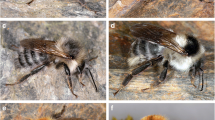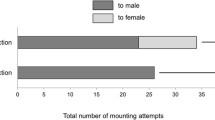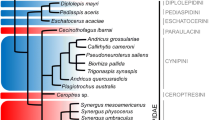Abstract
Pheromone glands are present in the abdominal sternites of the pregenital region in the male adults in all British species of Acanthosomatidae. Secretory units are most numerous in the hawthorn bugAcanthosoma haemorrhoidale and maternal bugElasmucha grisea, next most numerous in the birch bugElasmostethus interstinctus, and least numerous in the juniper bugCyphostethus tristriatus. The largest dorsal abdominal scent glands were found inCyphostetheus. Ordinary dermal glands are also present. They are most numerous along the lateral margins of the abdomen. It is possible that Pendergrast's organ is the source of a female-produced pheromone. Secretory units were numerous in this organ inC. tristriatus female adults.
Similar content being viewed by others
References
Aldrich, J.R. 1988a. Chemical ecology of the Heteroptera.Annu. Rev. Entomol. 33:211–238.
Aldrich, J.R. 1988b. Chemistry and Biological activity of pentatomoid sex pherornones, pp. 418–431,in H.G. Cutler (ed.). Biologically Active Natural Products: Potential Use in Agriculture. American Chemical Society Symposium Series 380, Washington, D.C.
Aldrich, J.R., Oliver, J.E., Lusby, W.R., Kochansky, J.P., andLockwood, J.A. 1987. Pheromone strains of the cosmopolitan pest,Nezara viridula (Heteroptera: Pentatomidae).J. Exp. Zool. 244:171–175.
Aldrich, J.R., Lusby, W.R., Marron, B.E., Nicolaou, K.C., Hoffmann, M.P., andWilson, L.T. 1989. Pheromone blends of green stink bugs and possible parasitoid selection.Naturwissenschaften 76:173–175.
Carayon, J. 1981. Dimorphisme sexuel des glandes tegumentaires et production de pheromones chez les Hemipteres Pentatomoidea.C.R. HEBD. Seanc. Acad. Sci., Paris 292:867–870.
Evans, C.E. 1989. Mass spectral studies of insect secretions. PhD Thesis. University of Wales (Cardiff).
Evans, C.E., Staddon, B.W., andGames, D.E. 1990. Analysis of gland secretions of Pentatomoidea (Heteroptera) by GC-MS techniques,in A.R. McCaffery and I.D. Wilson (eds.). The Chromatography and Isolation of Insect Hormones and Pheromones. Plenum Press, New York.
Games, D.E., andStaddon, B.W. 1973. Composition of scents from the larva of the milkweed bugOncopeltus fasciatus.J. Insect Physiol. 19:1527–1532.
Harris, V.E., andTodd, J.W. 1980. Male-mediated aggregation of male, female and 5th-instar southern green stink bugs and concomitant attraction of a tachinid parasite,Trichopoda pennipes.Entomol. Exp. Appl. 27:117–126.
Horwath, K.L., andRiddiford, L.M. 1988. Stage and segment specificity of the secretory cell of the dermal glands of the tobacco hornworm,Manduca sexta.Dev. Biol. 130:365–373.
Leston, D. 1953. Notes on the Ethiopean Pentatomoidea (Hemiptera): XVI, an acanthosomid from Angola, with remarks upon the status and morphology of Acanthosomidae Stal.Publ. Cult. cia Diamante Angola 16:121–132.
Maschwitz, U., andGutmann, C. 1979. Spur- und Alarmstoffe bei der gefleckten BratwanzeElasmucha grisea (Heteroptera: Acanthosomidae).Insectes Soc. 26:101–111.
Melber, A., Holscher, L., andSchmidt, G.H. 1980. Further studies on the social behaviour and its ecological significance inElasmucha grisea L.Zool. Anz., Jena. 205:27–38.
Pendergrast, J.G. 1953. Setose areas on the abdomen in females of some Acanthosominae (Het- eroptera; Pentatomidae).The Entomologist. 86:135–138.
Schaefer, C.W., andAhmad, I. 1987. The food plants of four pentatomoid families (Hemiptera: Acanthosornatidae, Tessaratomidae, Urostylidae, and Dinidoridae).Phytophaga 1:21–34.
Seymour, P.R. 1979. Invertebrates of Economic Importance in Britain, 3rd ed. Her Majesty's Stationery Office, London.
Southwood, T.R.E., andLeston, D. 1959. Land and Water Bugs of the British Isles. Warne, London.
Thornhill, R., andAlcock, J. 1983. The Evolution of Insect Mating Systems. Harvard University Press, Cambridge, Massachusetts.
Zdarek, J., andKontev, C. 1975. Some ethological aspects of reproduction inEurygaster integriceps (Heteroptera, Scutelleridae).Acta Entomol. Bohemoslov. 72:239–248.
Author information
Authors and Affiliations
Rights and permissions
About this article
Cite this article
Staddon, B.W. Male sternal pheromone glands in Acanthosomatid shield bugs from Britain. J Chem Ecol 16, 2195–2201 (1990). https://doi.org/10.1007/BF01026930
Received:
Accepted:
Issue Date:
DOI: https://doi.org/10.1007/BF01026930




